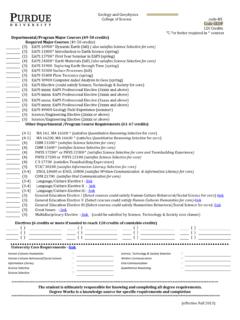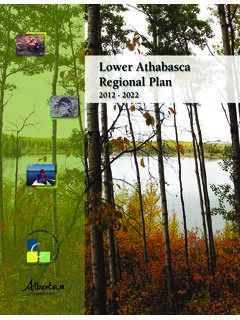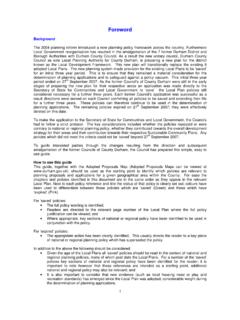Transcription of MP16 Draft Master Plan amended for public release …
1 DBCT Management Master plan 2016 Expansion Opportunities at the Dalrymple Bay Coal Terminal Page 2 of 86 Document Control Rev No Date Revision Details Author Verifier Approver 1 31/03/2016 Submission Document DBCTM PW AT 2 07/07/2016 Final DBCTM PW AT Document Owner Next revision date Jesse Knight 31/03/2017 Page 3 of 86 Table of Contents 1 EXECUTIVE SUMMARY .. 6 DBCT BACKGROUND (CHAPTER 2) .. 6 CURRENT OPERATIONS (CHAPTER 3) .. 6 FUTURE SUPPLY/DEMAND (CHAPTER 4) .. 7 DBCT EXPANSION OPTIONS (CHAPTER 5) .. 7 ENVIRONMENT (CHAPTER 6) .. 7 STAKEHOLDER CONSULTATION (CHAPTER 7) .. 8 2 INTRODUCTION & BACKGROUND .. 9 BACKGROUND TO DBCT .. 9 CURRENT ASSET DESCRIPTION .. 12 Basic configuration .. 12 Inloading .. 14 Stockyard .. 14 Outloading .. 17 WATER MANAGEMENT INFRASTRUCTURE.
2 18 CONTRACTUAL FRAMEWORK .. 18 Requirement for a Master plan .. 18 Whole of System Master Planning .. 20 Contractual Position .. 21 Contractual Position July 2010 .. 21 Contractual Position February 2016 .. 22 Regulatory Regime .. 22 GOVERNMENT LEGISLATION .. 23 Government Legislation .. 23 Proposals for Land Use and Site Development .. 24 3 CURRENT OPERATIONS .. 27 MODE OF OPERATION .. 27 DBCT Dedicated Stockpiling Option .. 28 Hybrid .. 28 Remnant Management .. 29 OPERATIONS .. 31 DBSCC ordering principles .. 31 Service Provision .. 32 Vessel Trends .. 32 Mine Load Points & Recharge Capability .. 33 4 SUPPLY/DEMAND BASED PROJECTIONS .. 34 THROUGHPUT GROWTH .. 34 METALLURGICAL COAL HISTORY .. 34 Page 4 of 86 SUPPLY .. 36 Domestic Indian production growth .. 36 Chinese Domestic production .. 37 DRIVERS OF DEMAND.
3 37 India .. 40 China .. 41 South Korea and Japan .. 41 Europe .. 42 Thermal coal .. 42 MINE DEVELOPMENT EXPANSION TRIGGERS .. 43 5 DBCT MTPA EXPANSION OPTIONS .. 45 DEVELOPMENT OBJECTIVES FOR DBCT .. 45 EXPANSION 46 Recap of Master plan 2009 .. 46 RECOMMENCEMENT OF EXPANSION STUDIES IN 2014 .. 47 SYSTEM CAPACITY MODELLING .. 48 EXPANSION PATHWAY .. 49 Zone 4 .. 49 8X Project .. 53 STACKERS ST1 AND ST2 UPGRADE .. 55 STOCKPILE AUGMENTATION PROJECT (SAP) .. 56 NEW IL4 AND IL2 UPGRADE .. 58 OL2 UPGRADE .. 59 INLOADING BUFFER STORAGE .. 60 Indicative cost of the 8X Project .. 62 9X Project .. 62 RAIL INFRASTRUCTURE .. 68 6 ENVIRONMENT .. 69 OVERVIEW / BACKGROUND .. 69 Existing Environmental Authorities / Regulatory Processes .. 70 PRELIMINARY ENVIRONMENTAL IMPACT ASSESSMENT .. 70 Air Quality .. 71 Noise and Vibration.
4 72 Visual Amenity .. 72 Cultural Heritage .. 72 Local Maritime Operations .. 73 Community and Social Impacts .. 73 Coastal Processes .. 73 Marine Ecology .. 74 Page 5 of 86 Terrestrial Ecology .. 74 Soil and Geology .. 74 Surface Water Quality and Hydrology .. 74 Transportation and Access .. 74 Waste Management .. 74 Land Tenure and Other Stakeholder Interests .. 75 POTENTIAL ENVIRONMENTAL AND PLANNING ISSUES .. 76 AIR QUALITY ENVIRONMENT POST EXPANSION .. 76 Emissions .. 78 Results .. 78 NOISE ENVIRONMENT POST EXPANSION .. 81 Licence Conditions .. 81 Assessment of 8X Pathway (including Zone 4) .. 82 Conclusions .. 83 7 STAKEHOLDER CONSULTATION .. 84 public CONSULTATION PROCESS .. 84 COMMUNITY ENGAGEMENT STRATEGY .. 84 KEY STAKEHOLDER RELATIONS PROGRAM .. 85 MANAGEMENT OF COMPLAINTS & ISSUES.
5 86 DBCT Management Master plan 2016 Executive Summary Page 6 of 86 1 Executive Summary The Bowen Basin has experienced strong production and demand growth for coal in the last 15 years. In order to accommodate this demand, DBCT Management Pty Limited ( DBCTM ) has responded by undertaking numerous capacity expansions. The DBCT 7X project was the most recent expansion and lifted terminal capacity to 85 million tonnes per annum (Mtpa), underwritten by long term take or pay contracts with the world s biggest mining companies. Since commissioning the new capacity in 2009, throughput has slowly increased in line with global demand. Further to contracted demand, DBCTM holds Access Applications seeking additional terminal capacity of up to Mtpa. Despite the recent slowing of global demand growth, Access Applications for post 85 Mtpa capacity at DBCT are still in place, with no indications that a material withdrawal will occur.
6 DBCT Management is obliged by the Port Services Agreement (PSA) and the Access Undertaking (AU) to accommodate the actual and reasonably anticipated future demand for the use of DBCT s Users and access seekers. Accordingly, DBCTM has continued to plan post 85 Mtpa expansions to take DBCT s nameplate capacity up to a maximum of 136 Mtpa. While an eventual return to demand growth is widely anticipated, the timing of the recovery has proven difficult to forecast. In the current environment it seems logical that when demand for expansion does return it will return in a more subdued and measured way, leading to a more incremental expansion requirement than anticipated in previous Master Plans. This Master plan outlines an incremental expansion pathway for DBCT. This Master plan (2016) takes into account recent legislative and policy changes at the Commonwealth and State levels regarding development along the Great Barrier Reef World Heritage Area (GBRWHA).
7 The Master plan reviews the preferred expansion path to meet the requirements of future capacity demand, without trying to predict when those individual expansion options might be activated. DBCT Background (Chapter 2) Chapter 2 reviews DBCTM s involvement in the terminal and describes the asset relevant to land use and geographical location, including a brief history of the terminal and the progression to DBCT s current configuration. Various elements of DBCT s operations are discussed, including a description of the major plant and machinery that allow the terminal to deliver 85 Mtpa of capacity. The region encompassing the terminal, in addition to the land leases that make up the terminal footprint are outlined for ease of reference. The chapter also deals with the contractual Master Planning process and DBCT Management s alignment with the Whole of System Master Planning function of the Integrated Logistics Company (ILCO).
8 The regulatory history is outlined in detail in this chapter, as is the contractual history following the purchase from government. Current Operations (Chapter 3) This chapter provides an overview of the current operations of DBCT, including; cargo assembly and hybrid stockpiling, the impact of service provision on terminal capacity, an overview of the remnant zone, and a summary of the independent capacity modelling results. DBCT has deviated away from a pure cargo assembly operation and introduced some multi DBCT Management Master plan 2016 Executive Summary Page 7 of 86 vessel hybrid stockpiling. Hybrid stockpiling typically occurs where multiple, near spaced vessel arrivals are chartered to load a single product that can be loaded into one larger stockpile rather than multiple smaller stockpiles, providing better utilisation of the stockyard and better throughput.
9 Use of rows 7 and the half row eight provide the operator with further options for completing vessels and avoiding remnant stockpiles in the cargo assembly zone. Service provision, including non common blending ratios, breakdowns, maintenance and smaller vessels can all erode terminal and supply chain capacity. Future Supply/Demand (Chapter 4) This chapter assesses global demand and supply prospects in the context of triggering further expansions at DBCT. Previous forecasts, based on leading industry analysis have been unreliable, due to a range of factors including the global financial crisis and more recently economic conditions in Australia s usual export destinations. DBCT Management expects stability in growth from the usual supply regions including Japan and South Korea, continued swing purchasing from China, while India and South East Asia drive further growth for coal handled by DBCT.
10 Competing suppliers do pose a threat to DBCT s demand, particularly Mozambican and Indian domestic coal production, however these regions are not expected to materially impact the long term growth of the Bowen Basin. Continuing demand out of the Bowen Basin is expected to drive demand for expansion capacity at DBCT. While there is no way to reliably predict the timing of the recovery, DBCT Management has developed this Master plan with the intent of having a clear development pathway ready, such that it can be triggered when the coal market rebounds. DBCT Expansion Options (Chapter 5) This chapter recaps expansion options identified in Master plan 2009 and considers them in the context of the materially different market conditions that currently exist. The chapter outlines a new approach to satisfying future demand with an incremental development pathway.





